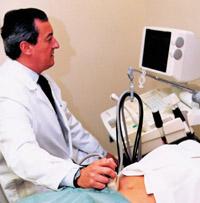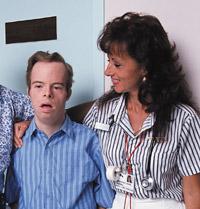Polyclinic Gipuzkoa assisted reproduction unit Latest techniques unit
2000/04/01 Murua Aitziber Iturria: Elhuyar aldizkaria

More and more couples have to take advantage of assisted reproduction to have their children. This increase is due to a series of changes in society.
As already mentioned, although the increase in the number of users has been remarkable in the evolution of assisted reproduction, research in this field of medicine and the development of the techniques used have gone in the same line.
The working group of the Gynaecological Office of Policlínica Gipuzkoa has guided us with detailed explanations about assisted reproduction and its forecasts for the future.
The degree of achievement of the techniques used in the assisted reproduction unit of Policlínica Gipuzkoa is high. Currently, through these techniques, in the assisted reproduction unit, successful results are largely guaranteed. Consequently, the number of pregnancies obtained through assisted reproduction techniques is practically equal to the number of normal pregnancies.
On the other hand, the degree of knowledge and control over concurrent pregnancies has also increased considerably.
In fact, if at the beginning of assisted reproduction the idea was socialized that simultaneous twins, triangular and superior pregnancies could increase considerably, at present this risk is practically marginalized. Consequently, the number of concurrent pregnancies generated by assisted reproduction is very small.
In addition, in cases of multiple pregnancies that may occur, always at the request of parents or under special circumstances, it has been approved by consensus the use of techniques of minimisation to reduce the embryos until being twins in the association of assisted reproduction units in Spain.
However, these techniques of reduction, especially taking into account the opposing ethical criteria that may arise, still apply only in some units assisted at the state level.
Gynaecological Consulting Gipuzkoa
The assisted reproduction unit of Policlínica Gipuzkoa is located in the Gynecological Office of the same. The professionals that make up the aforementioned office, from its start-up to the present, try to offer a new and modern form of gynecology uninterruptedly. These professionals specialized and created a team capable of facing the possible pathologies of women.
Of the nine doctors that make up the Gynecological Office, the director of the assisted reproductive unit is Jose Mari Gómez. For his part, the General Director of the office is Alfredo Otalora, specialist in gynecological endoscopy. The other units are governed by seven specialist professionals who are designated below: The ultrasound of Antonio Estomba, the juvenile gynecology of Fatima Azkue, the menopause of Fernando Cristóbal, the midwife Miguel Gabarain and Mertxe Maiztegi, the psychosexuality of Mari Jose Ruiz and the breast disease unit of Domingo Murgiondo.
Although the main center of the office is located in Policlínica Gipuzkoa, the Gynaecological Office of Gipuzkoa, in addition to Donostia-San Sebastian, has offices in Arrasate, Eibar and Irun. Most of the women who approach are from the Basque Country, Logroño, Santander and Burgos.
The San Sebastian unit in contact with the Dexeus Institute of Barcelona
The assisted reproduction unit of Policlínica Gipuzkoa has maintained since its foundation a direct relationship with the prestigious Dexeus Institute of Barcelona. In fact, the founding physician and head of the unit of San Sebastian, José Mari Gómez, was also founder of the assisted unit of the Dexeus Institute, where José Mari Gómez received training for his specialty in the aforementioned Institute.
Antonio Estomba, specialist in Ultrasound in the Polyclinic unit, like Jose Mari Gómez, has been trained at the Institute of Barcelona. Therefore, Jose Mari Gómez and Antonio Estomba, the Dexeus Institute, founder of the first child of the State, have had a school for their specialty. The professional training acquired in the Donostia-San Sebastian Unit is useful, among other things, using the same forms of stimulation used in the Dexeus Institute for assisted reproduction.
Together with the two doctors cited, the assisted reproduction unit is made up of the third professional, biologist Ainhoa Larrea.
Increasing the need for assisted reproduction
In Western society it is recognized that 15% of couples of reproductive age have reproductive problems.
There is talk of sterility when the young couple does not get pregnant after two years of sex. However, this two-year period depends on the age of the woman. That is, if the woman who wants to become pregnant is 30 years old, that term is reduced to 12 months. On the contrary, if the woman is over 35 years old, this period is limited to 6 months.
Couples with reproductive problems have increased over the years. Consequently, the number of couples who do not get the pregnancy after the aforementioned deadlines is increasing. The increase in these problems has been directly affected by a series of social changes. The main agents are two, the most important being related to the age of the woman.
The first reason is the progressive delay in the woman's maternity age. Between 29 and 35 years, female fertility decreases by 50%. On the contrary, in a 40-year-old woman fertility is in the order of 0. This last fact does not mean that in women over 40 years of age there are no pregnancies, but it is more difficult for them to arrive well at the end, since on the one hand the quality levels of the eggs decrease and on the other hand there are more abortions.
The second cause of increased fertility problems is decreased semen quality. It has been investigated that this decrease in quality may be mainly due to pollution, food and life forms.
Assisted reproduction techniques
In the assisted reproduction unit of Policlínica, when pregnancy is not achieved within the aforementioned periods, a special study is carried out to couples. Taking into account the importance of the results obtained for the couple, at present in the Donostia unit the study has been completed between one and two months.
Having on the table the results obtained from the study done to couples and once the causes of reproductive problems are known, the most appropriate reproductive technique is chosen for each case.
Five assisted reproduction techniques are used in the reproductive unit of Policlínica Gipuzkoa. In all cases, they encourage egg recovery and, above all, carry out continuous intermediate controls of high-resolution ultrasound.
In the Donostia unit, one of the most commonly used assisted reproduction techniques is the intermediate insemination of male semen (IAC), in vitro fertilization (IVF) and the ICSI method. The intermediate insemination of semen obtained from a donor is decreasing.
Let's look at assisted reproduction techniques separately.
Ovulation induction
20% of women with reproductive disabilities have ovarian problems. Ovulation by hormonal treatment favors the formation of more oocytes in the ovaries. This facilitates fertilization and therefore pregnancy. One
in two women using this technique can get pregnant within six months.
Artificial insemination with the partner (IAC)
This technique is one of the most used in couples with small reproductive problems.
By this technique they are incorporated into the recovery cycle of the ovaries useful sperm in the female uterus.
One in three couples using this technique can get a pregnancy within a four to six month treatment cycle.
Artificial insemination with a donor (IAD)
This increasingly less used assisted reproduction technique is applied when reproductive problems are male. The
characteristics of this technique are similar to the previous ones. The only difference is that the child belongs to the donor.
In vitro fertilization (IVF)

It is a technique used in many cases of reproductive problems of both women and men. This technique attempts to obtain as many female eggs as possible. Subsequently, the eggs are inseminated in laboratory, "in vitro", through man's semen. Once fertilization is achieved and its evolution confirmed, they move to the woman's uterus. The number of embryos currently transferred from the laboratory to the woman's uterus never exceeds three. The limitation of the number of embryos largely guarantees the low generation of multiple pregnancies.
ICSI Technology
The ICSI technique is applied to couples with few sperm. Through it a sperm is inserted into the laboratory and inserted into an egg, then passed to the woman. This technique also allows you to become pregnant in cases with serious semen problems.
Few multiple pregnancies
Although at the beginning of assisted reproduction the idea was socialized that simultaneous pregnancies of twins, triangles and older could increase considerably, at present this risk is practically marginalized. The techniques used in the reproduction unit of the Gynecological Office guarantee a high degree of control and achievement and the number of concurrent pregnancies generated by assisted reproduction is very reduced.
Obtaining three embryos per hundred women would allow reaching 30% of pregnancies per cycle. Of that 30%, 85% would correspond to pregnancies of an embryo, 13% to twins and 2% to triple.
In cases of multiple pregnancies that may occur, always at the request of parents or under special circumstances, it has been approved by mutual agreement in the Association of Assisted Reproduction Units of Spain (AECRA) the use of techniques of minimisation to reduce embryos more than until they are twins. Thanks to these reduction techniques it is possible to reduce the embryos until they are twins, which considerably increases the probability that the pregnancy will reach a good port. However, these techniques of reduction, especially taking into account the opposing ethical criteria that may arise, still apply only in some units assisted at the state level.
The importance of psychological agents
The professionals of the Gynecological Office highlight a characteristic that they consider essential to achieve good results through assisted reproduction. The importance of psychological agents in assisted reproduction. Since in this evolution the couple will suffer very conflicting moments, one of the main factors to achieve good results is the good relationship between couples and doctors of the reproductive unit.

Gai honi buruzko eduki gehiago
Elhuyarrek garatutako teknologia





